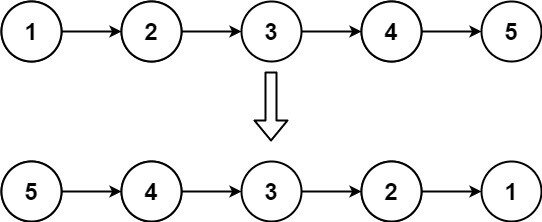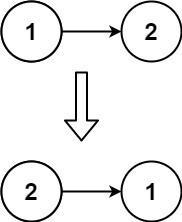Reverse a singly linked list.
這個篇章一開始也拋了一個問題出來,【反轉一個單向的鏈結陣列】,這問題感覺起來並不難解,只要從頭開始往後遍歷,把後面的節點都設定在開頭就好了,用文字有點難解釋,Explore Card 有提供圖片展示過程,以下直接進入反轉鏈結陣列的題目講解。
Given the head of a singly linked list, reverse the list, and return the reversed list.
Example 1:

Input: head = [1,2,3,4,5]
Output: [5,4,3,2,1]
Example 2:

Input: head = [1,2]
Output: [2,1]
Example 3:
Input: head = []
Output: []
Constraints:
[0, 5000].5000 <= Node.val <= 5000
Follow up: A linked list can be reversed either iteratively or recursively. Could you implement both?
這題我也嘗試了兩種解法,第一種解法跟Explore Card 上面的概念一樣,遍歷鏈結陣列的節點,不斷把後面的節點設定為鏈結陣列的開頭。
Runtime: 0 ms (97.58%)
Memory Usage: 40.8 MB
/**
* Definition for singly-linked list.
* public class ListNode {
* int val;
* ListNode next;
* ListNode() {}
* ListNode(int val) { this.val = val; }
* ListNode(int val, ListNode next) { this.val = val; this.next = next; }
* }
*/
class Solution {
public ListNode reverseList(ListNode head) {
if (head == null || head.next == null) return head;
ListNode result = null;
ListNode temp = null;
do {
temp = head.next;
head.next = result;
result = head;
head = temp;
} while (head != null);
return result;
}
}
第二個解法一樣是遍歷整個鏈結陣列,只是最終結果是不斷建立新的節點進行串聯,但在記憶體使用量上差不多,時間上卻慢了10%。
Runtime: 0 ms (86.57%)
Memory Usage: 40.9 MB
/**
* Definition for singly-linked list.
* public class ListNode {
* int val;
* ListNode next;
* ListNode() {}
* ListNode(int val) { this.val = val; }
* ListNode(int val, ListNode next) { this.val = val; this.next = next; }
* }
*/
class Solution {
public ListNode reverseList(ListNode head) {
if (head == null) return null;
ListNode result = new ListNode(head.val);
while (head.next != null) {
head = head.next;
result = new ListNode(head.val, result);
}
return result;
}
}
這個章節還有提供其他題目可以練習鏈結陣列,雖然Explore Card 是解完之後才會提供,但因為篇幅順序的關係,這邊就先講解它給的一些提示。
1. Going through some test cases will save you time.
我們一開始在解題的時候,可能寫完之後就直接執行了,並不太會自己列許多測案來驗證,這點在鏈結陣列尤其明顯,因為它確實不怎麼容易除錯,所以它第一個提示是說,【多用一些測試案例可以節省你的時間】。
2. Feel free to use several pointers at the same time.
上一個篇章有介紹到雙指針演算法,【如果有需要,也可以使用三指針、四指針或是更多指針】,不過每個指針的命名最好是跟要追蹤的問題有關,不然除錯起來也會很麻煩。
3. In many cases, you need to track the previous node of the current node.
在單向鏈結陣列中,我們沒辦法往前尋找已經看過的節點,【有些題目的解法並不只要存取目前的節點,也需要存取前一個節點】。
在反轉鏈結陣列所用到的概念,同時也是許多鏈結陣列問題的基礎,在面試時候也很常遇到相關的問題,所以至少要學會幾種鏈結陣列的解法。
![]()
